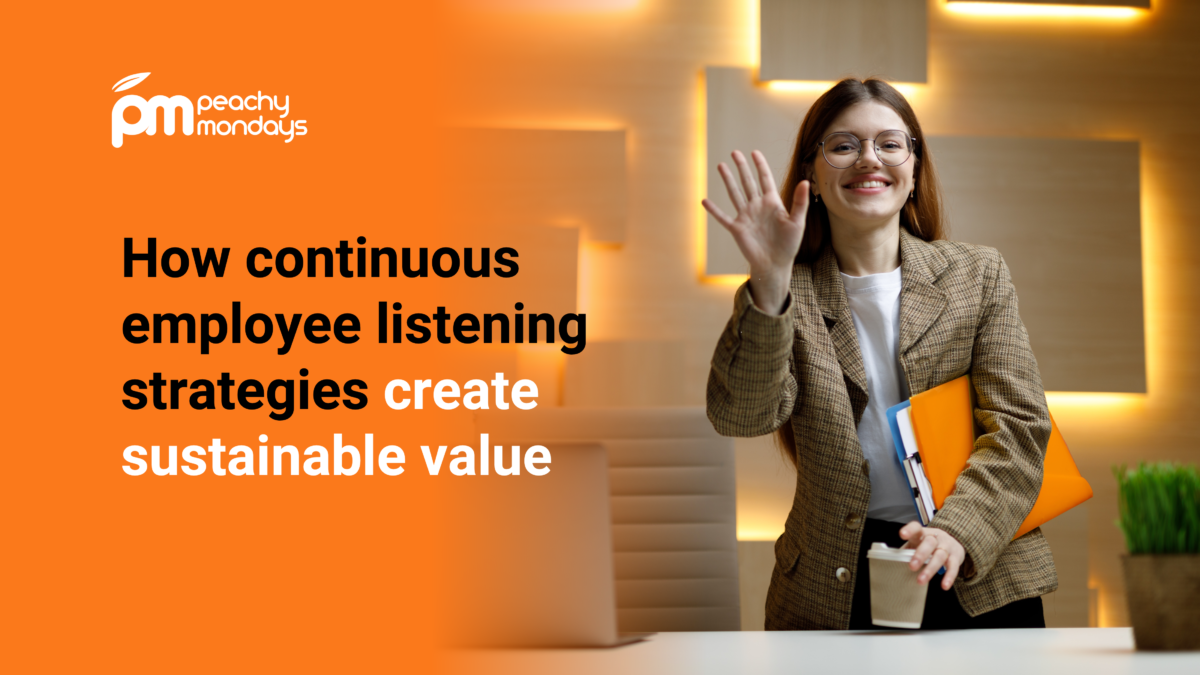How continuous employee listening strategies create sustainable value
The Significance of Employee Engagement
In today’s dynamic business landscape, employees demand more than a paycheck; they yearn for purpose, autonomy, and recognition. Engagement skyrockets when personal aspirations align with the organisational mission. The research underscores the link between engaged employees and heightened well-being, satisfaction, and productivity. And here’s the clincher: Top-tier companies strategically embed it into a continuous listening framework, unlocking category-defining performance and innovation.
The ripple effect is remarkable when employees feel heard, and their opinions valued.
We can create a collaborative and vibrant work environment by listening to feedback at every step in the employee lifecycle.
Constructing a Continuous Listening Framework
1. Consider how you listen – Traditional vs. Modern Listening:
- Traditional: A simple one-way approach, like a survey where responses are noted.
- Modern Two-Way Conversations: Initiating a dialogue post-feedback.
2. Consider when you listen – Basic to Advanced Approaches:
- Basic Strategy: Employing onboarding and offboarding surveys with regular feedback collection.
- Advanced Strategy: Recognising crucial feedback points, such as moments of career progression, changes in work dynamics, wellbeing concerns, performance evaluations, and more. Understand when feedback is most crucial for both employees and the organisation.
3. Consider why you are listening
With the rise of technology, multiple tools can streamline the process of employee listening. This isn’t just about surveys – but every method of listening. Before you construct a continuous listening framework, it’s essential to determine:
- Can you take action? Are we willing to make changes?
- Is it the right time?
- Are we using the the right tools for the job?
- Is a survey/focus group the only route we have to get the answer we’re looking for?
Employee Experience and Continuous Listening Strategies
Continuous Listening Strategies are particularly useful for determining whether your Employee Experience (the lived, every day working experience) is living up to the promises made in your Employee Value Proposition (the set of commitments or promises you make to employees regarding their work environment). How?
- Alignment with Feedback Points: Align feedback opportunities with moments that matter in an employee’s journey (like promotions, training, and role transitions). Regular feedback at these junctures provides insights into whether the EVP is being delivered as promised.
- Regular Audits: Use continuous feedback mechanisms to deep dive into difference elements of the EVP’s to make sure they align with employee needs.
- Engagement & Awareness: Use continuous feedback mechanisms to understand how well you’re embedding your EVP into daily communication and engagement initiatives, and what seems to be of more interest to different populations. This can help you tailor and adapt your proposition to meet the needs of a diverse workforce.
- Evolution Based on Feedback: The EVP should not be static. It must evolve based on feedback. Regular listening can pinpoint where the EVP needs adjustments or where it’s thriving. Regular listening also means you can tweak your approach and get an almost immediate guage of whether that worked, meaning you can continuously experiment to get the best outcome.
Incorporating the EVP into the continuous listening strategy ensures that an organisation acts on areas crucial to employees, driving engagement and retention.
Moving Forward: From Listening to Engaging
Most companies today will run a standard annual engagement survey asking 50+ questions and deriving an engagement score. However, passive listening isn’t enough. Embracing two-way dialogue is crucial. From the initial recruitment phase to exit interviews, open communication is the foundational thread weaving individuals into the fabric of a successful organisation.
The issue for HR leaders is more complex than conducting a survey and getting feedback and goes beyond creating channels to ‘hear’ employees. Genuine dialogue is essential in understanding the underlying causes influencing sentiment and engagement. The challenge is creating a culture, environment and the right tools to listen and act across the employee lifecycle. As we conclude, remember that the volume of conversations doesn’t measure an organisation’s success, but the quality and impact of these interactions define an organisation.
To learn more, join us for our forthcoming Roundtable Conference: From “Hello” to “Goodbye” – continuous employee listening strategies from pre-hire to offboarding.
Related Posts
Categories
- Case Study (13)
- Change and transformation (21)
- Connectedness (4)
- Culture (17)
- Design (10)
- Diversity and Inclusion (1)
- Effectiveness (16)
- Employee engagement (60)
- Employee experience (43)
- Employee Feedback (51)
- Employee Wellbeing (1)
- Events (10)
- Financial Wellbeing (1)
- Happiness (4)
- Internal Communications (10)
- News (24)
- Onboarding (1)
- Organisational Effectiveness (18)
- Uncategorized (3)




